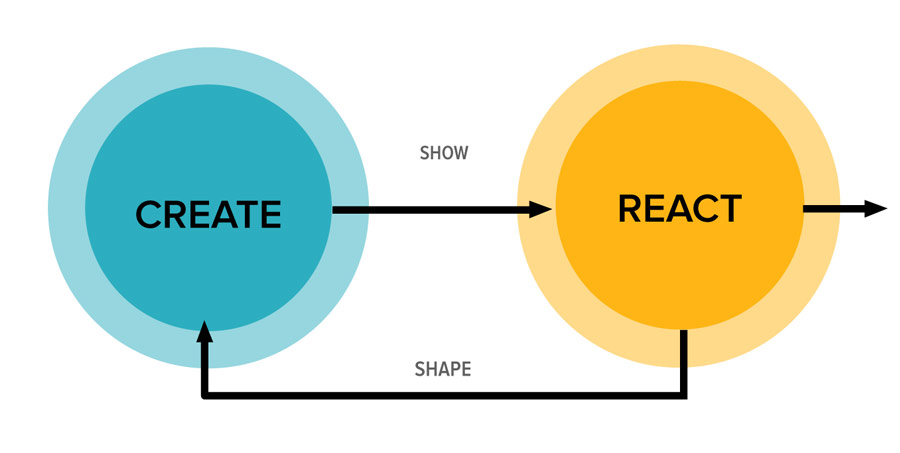When we talk to product managers and product designers, there is one question that we hear over and over again. 'How do you get your team to agree on what to build next?' Most people will agree that ideas are cheap, and the people on your team have lots of them. How then do you know which to pursue, and how do you keep the team engaged, when not everyone's ideas will be selected?
First, let's take a step back. We're firm believers that anyone can design and anyone can be a designer. There is no mystical superpower or genetic predisposition that gives someone the ability to do design. We don't believe that only designers or those at the top should be making decisions and passing them down to the rest of the team. Rather design is everyone's responsibility, and Progressive Design makes it easy for everyone to be involved.
A critical part of Progressive Design is the Design Feedback Loop. It's a simple process that encapsulates the 4 core components of what a product designer does to influence teams and move products forward. Using this process to structure debate around our designs builds and sustains momentum, as well as helps us to design better and faster.

Create, show, react, shape
Before we get into the 4 steps of structured debate, let's state some assumptions about your team and product design so that we're all clear on the context of what we're talking about here.
- You work with other people
Even if you are a company of one, we assume you are at least building a product that will be consumed by others (probably yourself included). Product Design is about creating something to be used by people, and if you're not designing with people in mind, then structured debate does not apply to you (and we're not even sure what it is exactly that you are doing). - These other people know things you don't
Your team is composed of people that know things you don't know, and you value them for this. Your customers may not know what they want, but they know (even if they can't communicate it) what will make them happy, what they will buy, and what they will reject. - You influence your product's impact
You may be the product manager, the CTO, a front end developer, an icon designer, a growth hacker, or a customer advocate, it really does not matter. What matters is that the work you do directly influences how your product changes the people that use it. - You care about creating something of value
If you're just looking to satisfy your manager or get points with the CEO for design that pops and sizzles then you can stop reading. To create value you also need to be (or are capable of being) a good listener. If you're not able to listen to your team or your customers, then these practices are a waste of time.
Great, we've got that all that taken care of, let's get into the good stuff.

Step one: Create
This may seem obvious but you (whoever you are) need to create something to be able to talk about it with your team. This may be a sketch of the interface or a coded proof of concept. It may be a visual mockup in photoshop, or copy for the site. Research even counts so long as you've synthesized it with the needs of the product and it has more depth than clippings from Fast Company.
Here are two things that do not fall into the create category and derail debate:
- An unprioritized list of things for other people to do
- Long speeches about the importance of doing a thing
These are things for sure, but in the context of product design they don't count in the create step.
Creating things is essential to creating momentum. Creation shows effort and investment. People know when you are half assing it and real effort inspires effort. The best way to get a conversation started in a constructive direction is to start with the work, the things you created and take it from there.
Creation creates clarity. Words are a poor substitute for many mediums (namely visual ones). Words also tend to be highly contextual to a specific conversation or person, and quickly lose their potency. When you lack clarity you'll likely end up debating the wrong thing, wasting time, and creating frustration for everyone.
Lastly if there is no creation, there is no product and there is no change. It's the most important thing that needs to be done if any result is expected. Ideas are cheap. Creation is the heart of design, and everyone should be doing it.

Step two: Show
You did something? That's great! Now you need to show it. Remember in grade school your math teacher always telling you to show your work? Well maybe you hated it then, but in design the work you show is more important than the answer. Don't be afraid to show early, and show often.
Remember all those smart people and customers you're working with, the only way you can take advantage of what they know is by showing your work. As a good product manager, encouraging the people on your team to show their work is your chief concern. Not because you are an authoritarian top down manager, but because you know that creation in a vacuum is toxic. It's not about you approving or disapproving of the work, it's about facilitating the showing of the work so that everyone on the team is contributing their expertise to the result.
Ed Catmull of Pixar talks about getting people to show their creative work everyday, how painful this is at first, and how critical it is to their creative process. It's more effort to show the work early, and it's not comfortable to show something before it's complete. But the benefit is that when you are done with the work, you are done. You already showed it to other people, and you already incorporated their feedback. No big reveal, no surprises or anxiety at the end.
Showing what you created is how you ask the question that you are going to debate. It's your opportunity to frame the problem. Think about a simple question like 'Is your coffee perfect?'. It primes the respondent to ponder the perfection of the coffee. Now ask 'Is your coffee too bitter', and you're making the person think about the bitterness, something they may never have considered. This is a simple example, but one that shows how the presentation (how you show the work) frames the debate you are structuring. Absence of framing gives every participant free reign to take the debate in whatever direction they like.

Step three: React
The direct result of showing your work is getting a reaction, and this of course is where most conversations take a turn down Random Feedback Street and then head straight down Complete Waste of Time Avenue. The key to getting the right kind of feedback to make the debate constructive is how you set it up with the work you created and showed to the group.
During a conversation, the team will have many reactions to the work you show. The model here is to mentally process these simply as reactions to the work. There is a natural inclination to try and work through the feedback right away and solve the problem. This only works for the most trivial decisions and fails for larger more nuanced problems.
Avoid the temptation to solve the problem right then and there. New ideas are fantastic and start flowing when you show new and interesting work. Make note of them and riff on them, but don't get stuck trying to solve a tough problem by coming up with more ideas and immediately evaluating them. It's easy to get into a 'lost keys' state of mind where you're racking your brain for a solution when none is immediately present. It's better to record the reactions and move on to the next problem. Nothing kills the energy of meeting like waiting for someone to find their 'lost keys'.
There are a couple different types of reactions that you may get:
- Positive reactions: You've done a good job, they liked what you did. Pay attention to the chord that you hit, is that what you were going for?
- Negative reactions: Your worst fear, they didn't like your work. Before you throw it all in the garbage ask yourself why. Did you show the work with the right context? Is there a better way you can present the work? Negative can be a good thing, it's validation that you're creating something interesting enough for someone to say 'No'.
- Neutrality: The worst of all outcomes. You showed something so lame or obvious that the viewers could not even be bothered to mildly dislike it. If you are not getting any reactions from the things you are creating then create something more interesting.
Reactions are an important way to learn something about the work you did and gain insights. You can fiddle with the pixels of your creation all day, but without fresh insights, it's not going to change much.

Step four: Shape
You created something, you showed it to someone and they reacted. Now what? Now you get to decide what happens next. This is where actual decision making and responsibility combine to allow the designer to make decisions and move the project forward.
Shaping happens outside the larger group, and has a single person with the final authority for making decisions. But there is a catch. This decision maker may have complete dictatorial power, but they are also responsible for showing these decisions to the larger team again and defending them. Ultimately they can shape the reactions in the following ways:
- Ignoring reactions: Don't think the person knew what they were talking about? Don't think it's the right thing to do? It is well within your rights to ignore a reaction, so long as it's a choice. Sometimes facing a hard truth can be difficult and we ignore it, this is not productive. For everything that we choose to ignore, we need to have a reason, and that reason needs to be communicated back to the person that gave the reaction.
- Incorporating reactions: Taking and implementing an idea wholesale is the easiest thing to do. Sometimes the feedback is deeply insightful and this makes sense. Otherwise ask yourself if this is the right way to go.
- Synthesizing reactions: What does the reaction mean? What does it mean in the context of the larger goals of the project? Most good reactions fall into this category. Insights that are not prescriptive, but change you perspective (if ever so slightly) and influence the next thing you create.
And then you do it all again
Here is the trick, there are not four steps to be done once, or even once per project. The way you get better at product design is by repeating these steps as quickly and as often as you can.
You can think about improving as a product designer by improving how you can optimize these four steps. How can you break up the work you create to show it more often, while still having something interesting to show? How can you effectively show the work to get reactions that will help you shape the work and then create more work? There are the questions we ask ourselves everyday, and almost everything that we write about has to do with these four practices.
Obvious right?
Maybe you went through this and found it all to be pretty obvious, great, that's how it should feel. Maybe this just feels like a Communications 101 playbook on how to work in a group. Well guess what, that's kinda what product design is, and that does not make it any easier. Remember how difficult it was to work in a three person group on a simple essay? Long nights of getting next to nothing done and having to tolerate smelly apartments and terrible music. Now try working on a running product with dozens of teammates, tens of thousands of active customers, and millions of potential people you could be selling to. This stuff is really hard.
What we hope, is that by giving you a mental model for thinking about how groups come to decisions you can be more successful. We live this stuff everyday and build it into everything that we do.

Notable and product design
We built Notable to help us live these steps and do them more effectively. When we create a feature in Notable, we think about how it fits into create, show, react and shape. From day one we believed that people should not create in Notable. The medium was too constrained. People should feel free to create anywhere (from napkins to photoshop) and be able to upload what they created into annotations, or create clickable prototypes, or even upload coded prototypes.
React was the core of Annotations, where you can leave notes directly on the work someone else did. We've been showing our work to clients for 17 years, and all of that thinking was baked into Influence, where you can easily create a story around the work you are showing and put it in the context of a process. Shape is an area that largely done outside Notable, but this is something that we want to explore.
More to share
This post was just about what the practices are. They are a mental model for thinking about what exactly we do as product designers. We've got much more to share about the methods we use to create and show our creations and how to react and shape reactions from others into better creations. We've learned a lot and are constantly learning more. We're looking forward to continuing to share what we learn and learn from others too. Thoughts?
